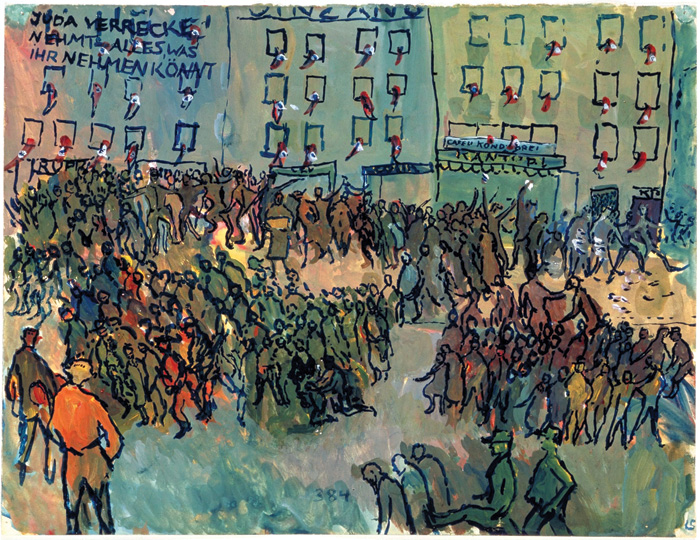
With its warm tones and bustling figures, this month’s image could – at first glance – appear almost to represent a scene of innocent activity.
The truth, however, could not be more different.
In fact, this brightly coloured gouache depicts the terrible events witnessed on 9/10 November 1938 by the 21-year-old German-Jewish artist Charlotte Salomon.
The pretty red flags fluttering from the windows are swastikas, while browns – representing Nazi uniforms – blend with the orange used to convey the burning of books of Kristallnacht.
This was the infamous Night of the Broken Glass, when paramilitaries and civilians throughout Germany took to the streets to attack homes, businesses, and religious buildings belonging to the country’s Jewish population.
The text in the top left of the painting reads: ‘Death to Jews! Grab what you can!’.
What can be meant by this weird regurgitation of Nazi propaganda, hastily written by a young Jewish artist? The picture forms part of an extraordinary mixed-media work created between 1940 and 1942.
Entitled Life? or Theatre? – and subtitled Ein Singspiel (or ‘a play with music’) – it comprises more than 800 gouaches, some overlaid with tracing paper on which text or dialogue has been written.
With directions for extracts of music to accompany the visuals, Salomon’s work defies categorisation. But the subject matter, represented in a way that foreshadows modern graphic novels, is very much her own family story.
Though details have been altered for expressionist and comic effect, the traumatic events of her life are ‘dramatised’ and examined in text and dialogue as if in a play.
Salomon was born into a well-off family in Berlin in 1917. Her parents were a doctor and a nurse, who had served in the First World War, and they continued working as such until the two professions became impossible under racial laws brought in by the National Socialists.
The family stayed in Berlin, where Charlotte was one of a handful of Jews in the mid-1930s able to attend art school.
At 16, she witnessed Hitler’s election to the German chancellorship. She depicts this theme in Life? or Theatre? with the same devastating irony evident elsewhere: a throng of indistinguishable brown shirts holds a vast flag aloft.
However, the swastika on their flag is reversed and therefore reverts to being the ancient Hindu symbol of peace.
The date of 30 January 1933 is daubed large in the middle of the image, as if we all need to pay heed to what that dreadful day signifies. The overlaid text reads ‘The swastika – a symbol bright of hope. The day for freedom and for bread now dawns’.
Shortly after Kristallnacht, Charlotte’s father was arrested and spent time in a detention camp.
Although he was later released, he decided in 1938 that Charlotte should be sent for safety to Villefranche in France, where her grandparents were living.
Yet the political environment was not the only problem with which Charlotte had to contend. An appalling family history of mental illness and violent suicide was kept from the young artist, until it broke through and became the catalyst for the creative maelstrom that followed.
Following the suicide of her grand- mother shortly after the outbreak of war in 1939, Charlotte discovered that her aunt, her own mother, and several other close relatives had also taken their own lives.
Falling into despair and mental break- down, she too considered ending her life. The remedy that enabled her to resist thoughts of death was to create ‘something wildly eccentric’: the extraordinary visual-confessional-cum-fiction-project that became Life? or Theatre?
In this, the intrusion of real historical events makes us appreciate the nature of living through those times.
As the dangers of living in German-occupied France grew, Salomon entrusted her work to a friend for safekeeping, saying ‘Look after this – it is my life.’ Thankfully, it was uncovered by her parents after the war and put on public show.
Charlotte herself, however, was not so fortunate. In 1943, then five-months pregnant, she was arrested and deported to Auschwitz, where she was murdered in the gas chambers immediately on arrival. She was 26 years old.
Over 200 gouaches from Life? or Theatre? can now be seen at an exhibition at the Jewish Museum London until 1 March 2020. For further information and a playlist of music that accompanies the image click here.

This article was published in the February 2020 issue of Military History Matters. To find out more about subscribing to the magazine, click here.




This is a powerful and thought-provoking way to introduce a piece of art. The initial description creates a stark contrast to the horrific reality depicted by Charlotte Salomon. Highlighting the hidden symbolism, like the swastikas disguised as flags and the burning books blended into the colors, forces the reader to look deeper. It’s a chilling reminder of the true events of Kristallnacht. Thank you for sharing this important piece of history through art.